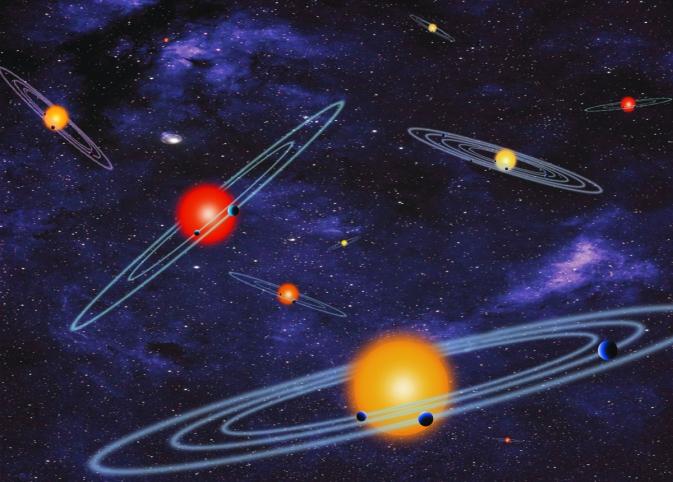Kepler Mission Announces New Planet Influx
Viewing systems edge-on, planets can be observed to pass in front of stars. NASA’s Kepler mission observes this phenomenon, called transit, in order to identify candidate exoplanets. This artist’s interpretation displays many such transiting planets, not to scale.
Since its launch in 2009, the Kepler spacecraft has been continuously monitoring minute changes in the brightnesses of thousands of stars in our galaxy. On February 27, its efforts came to fruition as NASA announced the confirmation of 715 new Kepler-identified exoplanets.
Candidate planets are identified when a star is observed to experience a temporary slight dimming. This dimming is often caused by the transit of a planet between the star and the satellite. However, other astronomical phenomena, such as the partial blocking of the target star by another star, can cause the same effects.
“Those observations have revealed more than 3600 examples of this telltale dimming that looks tantalizingly like planet transits. However, we’ve been very careful to refer to those signals only as exoplanet candidates because there are astronomical phenomena out there that can mimic the transit of a planet,” said Douglas Hudgins, exoplanet program scientist at NASA.
In the past, candidates identified by dimming were evaluated in a painstaking process that produced few results and much frustration.
“Going from planet candidates to verified Kepler planets has been a real bottleneck,” said planetary scientist and team co-leader Jack Lissauer, “it has required a lot of effort… and the planes have just been trickling through.”
Lissauer described the new method, called verification by multiplicity, as an “opening of the bottle neck,” and stated, “we’ve now developed a process to verify multiple planet candidates in bulk to deliver planets wholesale and have used it to unveil a veritable bonanza of new worlds.”
Verification by multiplicity is based on the statistical analysis that if all 3600 candidate planets were randomly distributed among all the stars under observation, very few stars would have more than one satellite. According to data, however, more than 400 stars were seen to have more than one transiting object.
Additionally, while there are binary star systems (systems of two stars orbiting around each other), a third star would unbalance the system to a point where the orbits would not be sustainable. The only way to maintain a system with many orbiting bodies is to have those orbiting bodies be significantly less massive than the central star, such as is the case with planets.
The extrapolation of this astrophysical analysis leads scientists to hold that in systems where more than one body causes dimming, those bodies must be planets and not stars. The application of this method to the Kepler data lead to the confirmation of 715 new planets orbiting around 305 different stars. This rate of planet discovery is unprecedented; since the first exoplanet was discovered 20 years ago, discovery rates from all sources combined have only exceeded 100 per year starting in 2009. With this announcement begins an era of stellar rates of exoplanet confirmation.
From the Kepler mission alone, “With each additional year, we should be able to bring in about a hundred or so planets,” said Lissauer.
The types of planets discovered is also significantly impacted by the new method. With older methods, larger planets were easier to identify and thus, prior to Wednesday, the majority of known exoplanets were around the size of Jupiter. Using verification by multiplicity, however, smaller planets are more easily identifiable. Most of the planets announced in this first wave are larger than Earth but smaller than Neptune.
This size is perfect for the accomplishment of Kepler’s primary goal of identifying planets capable of supporting life. However, because of the nature of the method, planets with larger orbits require more time to be validated than planets with smaller orbits. Most of these smaller orbits are too close to their stars to be in a habitable zone, which is the size of orbit where temperatures allow for liquid water.
Of Wednesday’s Kepler discoveries, four lie in the habitable zone.
Search for ExtraTerrestrial Intelligence Institute research scientist and co-leader of the team Jason Rowe said “The more we explore the more we find familiar traces of ourselves amongst the stars that remind us home.”
In the coming years, however, there will be enough time to validate planets with larger orbits and hopefully expand the group of potential life hosts.
Regardless of whether we are alone in terms of life, the new planets show that we are not alone in terms of solar system characteristics. Previous exoplanetary demographics indicated that small rocky planets such as Earth might be among the minority. The new findings show that systems such as ours, in which many smaller rocky planets orbit fairly near a star in elliptical orbits on a flat plane, are much more common than demonstrated before.










